|
|
Here’s an interesting article by one of our local Eugene Chapter member bloggers:
It is always exciting to encounter a fresh topic that has escaped attention, yet with a little investigation, demands it. So it is with the story of A1 / A2 milk. I first became aware of the existence of this issue at a potluck dinner with health-conscious fellow diners. As it turns out, this is old news to residents of New Zealand, where a few researchers and entrepreneurs have been promoting the virtues of A2 milk for about a decade. The story is about the role of a milk protein, beta-casein, that can take on two very similar forms, called A1 and A2, depending upon a single simple mutation of one gene. The A1 form of the beta-casein, upon digestion, breaks down into beta-casomorphin-7 (BCM7), a fairly stable and strong opiate which appears to cause health problems in some people some of the time. Meanwhile, the A2 beta casein proteins are digested completely and don’t generate the problematic BCM7.
The evidence suggests that BCM7 can trigger the auto-immune response responsible for Type 1 diabetes, and it is implicated in arterial damage and consequently could be a factor in heart disease. In addition, there is evidence for connections between BCM7 and autism, schizophrenia, sudden infant death syndrome (SIDS) and milk intolerance. read more >>
For the full article and many others please check out squashpractice.wordpress.com. And take a guess about which “potluck dinner with health-conscious fellow diners” he originally learned this little gem. You never know what you’ll learn at our Potlucks!
As you might have already gathered, I am on a lot of email lists. Here is something I got from Charles Eisenstein (see below for more information about Charles). I thought this was a beautiful article and recommend it:
Hi everyone,
I haven’t been publishing much recently because I’m working on a new book, but here is a nice little essay that draws on some of the ideas I’m working on: 2013: The space between stories. What the book is about is the transition from the “old story” to the new, on a personal and cultural level. How do we make the transition, when so much of our “trying” comes from, and strengthens, old-story habits? How do we serve as change agents? How do we accomplish what is, according to the old understanding of cause and effect, impossible? How do we stay practical, even as our understanding of practicality undergoes rapid change?…
Read 2013: The space between stories
Charles Eisenstein has spoken at the Wise Traditions 2009 Conference, written articles for Wise Traditions Journal, and has spoken in Eugene.
For more information see:
An evening with Charles Eisenstein exploring Sacred Economics
Wise Traditions Conference 2012:
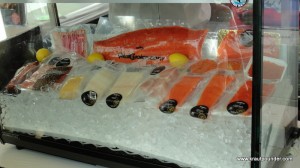 - I had salmon roe from Vital Choice Seafoods
Underground Breakin’Fast:
In the morning we went downstairs for the Underground Breakin’Fast sponsored by the Farm to Consumer Legal Defense Fund. I donated $10. As donor gifts I received 10 “Donor Moolah” (DM). By going around to different vendor’s booths I was able to turn in the DM in exchange for food. It was a fund-raiser for FTCLDF. The vendors donated the food and the FTCLDF keeps the donated money. There were many foods available to choose from. I had a (generous) ounce of salmon roe from Vital Choice Seafood and 8 ounces of raw Organic Pastures Dairy milk that morning and felt good until lunch.
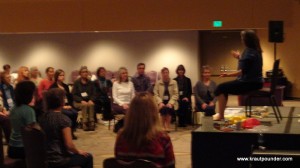 Kim Thompson demonstrated sitting comfortably
How to Sit Comfortably:
During Underground Breakin’Fast Kim Thompson held a session on Sitting Comfortably. I stopped in to drop off some salmon roe for my roommate. I found it so interesting that I stayed for the rest of the talk. She showed a spine with all the vertebra lined up with even spacing between each one. She told us that this is the shape that the spine makes naturally and it wants to be this way. She discussed how to sit and use your body in the best way to feel good after a day in a conference. Her tips included sitting with your pelvis tilted backward (sitting on your “sit bones). Use a rolled up towel to help elevate the back of your pelvis if needed. Don’t overemphasize the lower curve to your spine, keep the ribcage upright. Let your shoulders roll back, but don’t pinch your shoulder blades together.
A question about Kegels also generated some wonderful discussion about the natural support structure of a woman’s pelvis. She said that Kegels have never been proven to do any good. When the spine is in the correct position and the pelvis is tilted back all the internal organs are supported by a cradle of bone! This is quite a different story than the one about the soft tissues that are commonly referred to as the “pelvic floor”.
Tracks:
The rest of the day was broken up into 5 “Tracks”, with three 2-hour sessions each.
- Track I – Nourishing Traditional Diets
- Track II – Gut & Psychology Syndrome
- Track III – Nutrition & Behavior
- Track IV – Science of Farming
- Track V – Cooking
Everyone is free to move about in the different tracks, which is usually what I do. All the tracks sounded wonderful, and it is always hard to chose between them. The theme of this year’s conference was Nutrition & Behavior, which is a really fascinating and important topic for me, so this time I stayed in the Nutrition & Behavior track all day.
 Sugar is more addictive than cocaine!
Sugar Addiction:
The first session I attended was Sugar Addiction: Defeating the Greatest Dietary Crisis of all Time. It was excellent. The Eugene Chapter purchased DVDs, and I will definitely be showing all of the presentations by Julia Ross when the DVDs arrive.
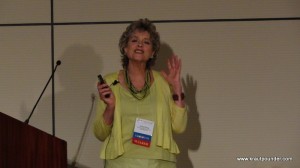 Julia Ross
Julia Ross is a psychotherapist in the bay area, and the author of The Diet Cure, and The Mood Cure. Throughout this track she spoke at length on the necessity of sufficient protein in the diet for brain health and mood regulation.
Proteins are broken down in the digestive system into their component amino acids. Amino acids are then converted into neurotransmitters, which the brain uses to carry messages. When one or more of these neurotransmitters are deficient the results are mood imbalances, anger, irrationality, loss of emotional control, sleep disorders, food cravings, food-drug-alcohol dependencies, and more. The brain can become deficient in neurotransmitters due to stress, illness, poor dietary choices, poor digestion, and other reasons. A traditional diet that includes adequate fats and protein supplies the necessary amino acids, but when there is already a deficiency in the brain diet alone may not be enough to restore balance. Supplemental amino acids are quickly converted into neurotransmitters and mood problems and cravings for food or drugs are eliminated. These supplements are inexpensive and readily available in natural food stores. After a few months of supplementation people usually no longer need the extra amino acids.
 US diet 1970 to 2012
The use and abuse of sugar has been going up since 1972, when the first USDA food pyramid came out. She called the 1970’s “The first decade of Famine”. During that time fat was cut 45% to 35%, refined sweets and starches increased over 50%, high fructose corn syrup was added to foods, low calorie dieting boomed (including skipping meals, fasting, cleansing, caffeine, tobacco and diet pills, and low protein vegetarian diets).
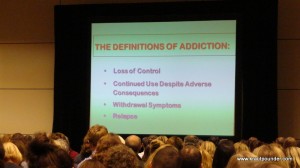 Definitions of Addiction
Sugar meets the definition of an addictive substance. In her practice, Julia Ross found that sugar cravings could be halted 80% of the time using supplemental amino acids. L-Glutamine was one that was particularly helpful in stopping sugar cravings. She said that for fast results one could open a capsule of Glutamine and empty it directly into the mouth. The amino acid is absorbed through the mucus membranes and can quickly halt cravings.
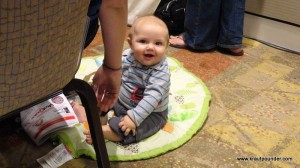 Cute baby enjoying the conference
I’ve been using Glutamine with my son and myself since then. I open a capsule into some water and add a pinch of stevia to make it more appealing (yes, I know I am still using the sweet taste for motivation). I believe that I have seen a difference in behavior, especially when I pick him up from school. He is hungry and usually begs for sweets. Now he is willing to eat savory protein and fat based foods before having a sweet.
I would love to learn more about using nutrition and amino acids to improve mood and emotions. Everywhere I look I see people who are depressed, manic, obsessive compulsive, angry and more. I am especially worried about the younger generations. I think a big part it has to do with nutrition. Just like in the faces that Dr. Price observed, you can see the loss of nutrients in their behavior as well. We are seeing the effects of multiple generations of poor diet take its toll on the children.
Lunch:
 Traffic Jam
Lunch had wonderful food, but the logistics was a chaotic mess! I got out of the first session and ran smack into a traffic-jam of people. It turns out we were in line for lunch, but no one knew for sure if it was a line for lunch and if we were moving or not. The line was a total standstill as it went past vendor’s tables. I eventually made it into the lunchroom (a loooooong was down the various hallways) and got my lunch.
 Lunch line
We had Baby Greens Salad, Sauerkraut, Grilled Pork Sausages, Beef Sausages, Molasses Baked Beans, Warm Bavarian Potato Salad, and Sourdough Bread with deep yellow Butter. And for dessert Baked Apples with Raw Honey.
After lunch I walked back up the lunch line and found Charlotte Smith (or rather she found me). I followed her party back into the lunchroom and we talked while they ate. I was very happy to have a chance to talk with her and called my farmer right after that and told her to get herself signed up for the Raw Milk Seminar in Oregon!
Wise Traditions Conference 2012:
The Depression and Anxiety Epidemic:
 Symptoms of Low Serotonin  Julia Ross 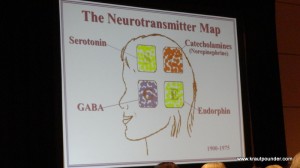 The Neurotransmitter Map 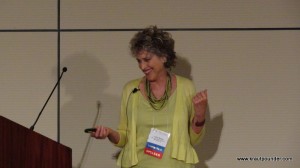 Julia Ross
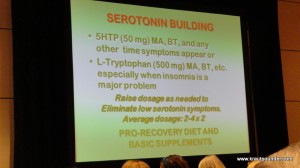 Serotonin Building I returned to the Nutrition & Behavior track for the session on The Depression and Anxiety Epidemic. Julia Ross talked a lot about the importance of Serotonin. Serotonin is made from the essential amino acid Tryptophan.
What a cool idea! I hope you will participate. This comes to us from a local member:
This isin’t specifically WAPF related… but I wondered if you could share…
I have an idea. I am super excited about it. I want to put together an e-book. ‘Natural Childbirth in Eugene”. Interested in contributing? It will be a benefit (haven’t decided for where yet…any ideas?) I loved reading others birth stories… how cool would it be to have a compilation of stories from your HOME TOWN? So… did you have a natural birth? Did you have a natural birth planned but that didn’t happen? Did you plan a medical birth but had a natural birth? I want to hear them all! Home, birth center, hospital, doesn’t matter. Want to contribute? Email me your birth story! jacquelynbyers@gmail.com
Jacquelyn Byers
Several of us volunteers from the Eugene Chapter made it down to California (and back) for the Wise Traditions Conference 2012 in Santa Clara, California.
It was awesome!
I am going to post my experiences in several parts.
Wednesday:
 Three of us drove down together. It took us about nine hours to get there, but we traded off drivers every 2 hours and talked about nutrition the whole time, so the time went by pretty quickly. We also listened to several podcasts, one of which was by Chris Kressor, who we later got to hear in person. Very cool. Three of us drove down together. It took us about nine hours to get there, but we traded off drivers every 2 hours and talked about nutrition the whole time, so the time went by pretty quickly. We also listened to several podcasts, one of which was by Chris Kressor, who we later got to hear in person. Very cool.
We decided to make a detour to stop at Three Stone Hearth in Berkley. Three Stone Hearth is a CSK (Community Supported Kitchen) that makes nourishing-traditions type food for people in the bay area. They have an online ordering system where people can pre-order broth, soup, fermented foods and more. They then come pick up their food on certain days. We made it there during their pick up time, so we got to see the facility in opperation.
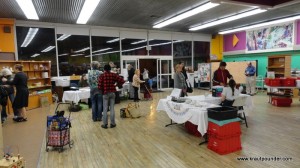
We were able to sample a couple of items, and purchase some more from the cooler. They have some foods available for walk-in customers. I don’t know if you can read them in the photos (and I figure the prices are higher if you buy them off the shelf) but check out some of these prices:

Whey $5.00/pt
Soaked Oatmeal $6.00/qt
Yogurt cream $5.00/half pt
Grass-fed beef broth $12.00/qt
Pastured chicken broth $13.00/qt
Pickle relish $9.00/pt
West African fritter dough $8.00/pt
I think it is wonderful that they are providing these foods to people who don’t have the time to make it themselves. Personally, I suggest coming to our classes, and learning to make them yourselves!
Wise Traditions Conference 2012:
Wise Traditions Conference 2012:
Thursday:
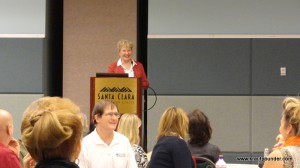 Sally Fallon Morell at the Chapter Leader Meeting Thursday morning the conference started with the Chapter Leader meeting. This had up until this year been held on the Monday following the conference, but they moved it this year.
The Chapter Leader’s meeting, where you might think we learn the secret handshakes and other mysterious stuff, was actually taken up with presentations of information for us to take back to our chapters.
Sally Fallon Morell:
Our first speaker was Sally Fallon Morell (president of the Weston A. Price Foundation and author of Nourishing Traditions). We learned that there are now 15,700 members in WAPF! There are 580 chapter leaders worldwide. Ten percent of them are overseas with New Zealand having the highest number of members per capita of any country. Sally keeps saying; This is truly an international organization now.
Pete Kennedy:
Our next presenter was Pete Kennedy, is a lawyer and president of the Farm to Consumer Legal Defense Fund (http://www.farmtoconsumer.org/). The Farm to Consumer Legal Defense Fund was created by Weston Price people to “Protect the constitutional right of the nation’s family farms and artisan food producers to provide processed and unprocessed farm foods directly to consumers through any legal means.” (read the FTCLDF mission statement)
Pete spoke about membership in the FTCLDF. There are 4 membership categories:
- Farmer – $125/yr
- Consumer – $50/yr
- Associates – $250/yr
- Artisan Producers – $125/yr
The memberships include free legal advice, and the possibility of legal representation (see http://www.farmtoconsumer.org/benefits.html for more info). They provide a 24-hour 1-800 number for members to call in the case of situations such as the health department coming to your door. We highly recommend everyone join this organization.
 Chapter Leader group photo Pete also gave us updates on some recent cases they had taken on. You may have heard about one in particular that resulted in a statement by the FDA that made the rounds on the internet. The FDA went on record as saying that (in their opinion) we have no fundamental right to consume or feed our children the foods of our choice! (see more: http://farmtoconsumer.org/litigation-FDA-status.htm) Wow, and who gave them that power? I say its time to take that power back into our own hands.
Chapter Leader Photo:
Next we took a break for our Chapter Leader group photo.
Elisa vander-Hout-Schmidt:
Next we heard from Elisa vander-Hout-Schmidt, who is the wife of Michael Schmidt. Michael is a raw milk farmer in Canada where it is illegal to sell raw milk. Michael has gone to jail and on a hunger strike in order to forward the raw milk movement in Canada.
Gary Cox:
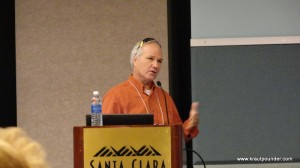 Gary Cox 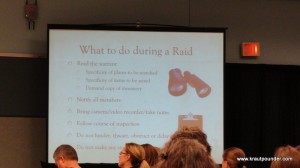 What to do during a raid Gary Cox from the Farm to Consumer Legal Defense Fund gave a wonderful presentation on what you should do in case of a farm raid (We also had in the audience Victoria Bloch, a chapter leader from Los Angeles, who went to jail in the raid on Rawsome Foods. She said she was going to have a T-Shirt made that said “I’ve been strip-searched for Raw Milk!”)
None of us like to think of the possibility of a raid happening to our farmer, but the presentation was very good. I am going to try to get a hold of the PowerPoint to show locally. Contact me if you would like more info.
In case you can’t read the points on the What to do during a raid photo, they are (you can also click on any of the photos to view them larger):
- Read the warrant
- Specificity of places to be searched
- Specificity of items to be seized
- Demand copy of inventory
- Notify all members
- Bring Camera/video recorder / take notes
- Follow course of inspection
- Do not hinder, thwart, obstruct or delay the inspection
- Do not make any statements
And of course, if you are a member in the Farm to Consumer Legal Defense Fund, the very first thing to do is call the 1-800 hotline and get some legal advice! Gary talked about situations where the health inspector was in the process of telling the farmer to dump all their food in the trash, when the FTCLDF discovered that the warrant didn’t give them the right to do this at all.
 Beef Stew, Herb Roasted Acorn Squash, Winter Greens with Shaved Fennel and Celeriac, Sauerkraut and Butter Lunch:
Lunch was provided by New Trends Publishing (publishers of Nourishing Traditions and many other great books). We had the first of our wonderful meals at this conference.
We had Beef Stew, Herb Roasted Acorn Squash, Winter Greens with Shaved Fennel and Celeriac, Sauerkraut and Butter. The Herb Roasted Acorn Squash was my favorite! Makes my mouth water just to think about it. For desert we had roasted bananas with coconut. It was way too sweet for my tastes, and I wished I’d finished with a second helping of the squash.
Charlotte Smith:
After lunch we had a presentation from Charlotte Smith of Champoeg Creamery (right here in Oregon!). Champoeg Creamery is the first farm to be certified by the Raw Milk Institute (RAWMI). The Raw Milk Institute was launched last year. Mark McAfee of Organic Pastures Dairy in California was one of the founders.
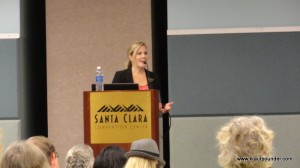 Charlotte Smith She gave a touching account of the situation that lead to her creating the Oregon Raw Milk Producers Association. Charlotte told the story of a farm in her area that had a recent serious outbreak of disease. She had heard that this farm wasn’t clean. She felt so helpless to watch this terrible thing happen, and wanted to do something to prevent future outbreaks. So she got the idea of founding the Oregon Raw Milk Producers Association in order to provide safety, structure and education to raw milk in Oregon. Mark McAfee joined her on stage and she and Mark talked about their common goal of responsible and safe raw milk production. We saw photos of her farm, and heard about her experiences with becoming certified with RAWMI. I was very pleased to hear about the work that Charlotte is doing with raw milk producers. She is also the organizer of the Raw Milk Seminar in Junction City (at Deck Family Farm on November 19th).
Sara Pope:
 Sarah Pope Sara Pope is a chapter leader in Florida, and has contributed many videos on the Weston A. Price website. She talked about introducing raw milk to moms. She started off saying that she was from the South, and they have a saying:
“If Momma ain’t happy… Noooooooobody happy”
She said that the mommas she came into contact with are not happy. More moms are having to work outside the home, run single-family households, take care of their families, and their kids are getting more and more sick. The moms she sees have lost their fear of raw milk, and are desperate for anything that will help their children. She gave some strategies for introducing raw milk to moms. She said to talk one on one. Moms are getting more suspicious of “authorities” telling them what to do. Especially when so much of the info is in conflict with each other. Raw milk is helping children recover their health.
Judith McGeary:
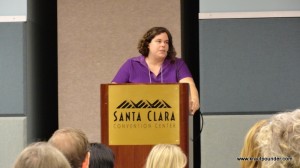 Judith McGeary Judith McGeary is a lawyer and organizer that has been instrumental in fighting back the National Animal Identification System (NAIS). She said that for a history of the farm bureau, etc. a great book was called “Dollar Harvest”. She also said that in the 2008 campaign Obama made a promise to label GMOs. She said there is a good YouTube video of this.
I found this one:
http://www.youtube.com/watch?v=zqaaB6NE1TI
We ended the Chapter Leaders meeting with a panel discussion. In years past we had breakout sessions, in which we meet in small groups around tables, and each table discusses a different subject. I was kind of disappointed not to have one this time.
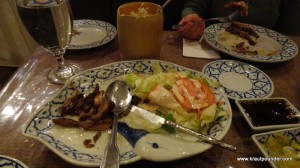 Thai meal at restaurant in San Jose After the day’s events my traveling companions and I drove into San Jose to find some dinner. We ate at a Thai restaurant. We had some roast duck, a chicken thing (that I can’t remember the name of), salad, and a couple of sauces. One side dish was a pineapple chutney-type sauce that we figured had traditionally been fermented. Jasmine rice was served in a cup made from a piece of real bamboo.
Wise Traditions Conference 2012:
I was organizing files on my computer and ran across this file called “The Local Connection: Natural Therapeutics for Preventing, or Reducing the Severity of, Influenza Infection” sent to me by local Eugene Chapter member, Nick Routledge. It describes how a diet based on the Weston A. Price Foundation principles is part of a program to improve immune system.
The Local Connection: Natural Therapeutics for Preventing,
or Reducing the Severity of, Influenza Infection.
By Nick Routledge and Sonja Ljungdahl
Eugene-Springfield.
Version 2.22 (Updated September 26, 2009)
A wealth of evidence clearly shows that simple steps to support general health are a highly effective way of significantly reducing the likelihood of influenza infection and of markedly lessening the severity of symptoms should infection occur. Here’s a simple guide to stacking the odds in your favor.
1. Food as medicine
We eat three times a day. Why not have food be your medicine? A truly coherent diet not only supports your health but the wellbeing of everything and everybody around you – local soils, water, flora, fauna and community. Vitamin and mineral content of food varies enormously depending on the methods used to raise that food: the micronutrient content of American fruits, vegetables and meat products has declined significantly during the last fifty years.
Even among those of us eating balanced diets, chronic, commonplace, nutritional deficiencies confirm that most commercially-sourced foods are now ‘anemic’, simply lacking the nutritional density of their forebears. A sound diet is therefore keenly alert not only to the balance of its ingredients, and the aptness of its preparation but, crucially, the integrity of its source. Your best medicine is local food raised on well-stewarded soils.
2. Support healthy digestion year-round.
We strongly recommend a diet consisting of whole foods that are fresh, nutrient-dense, properly prepared and raised by local growers you trust….
To read the whole article download this file: preventionv22.pdf
(right click, and “save as”)
This comes to us from a local Eugene Chapter member. The New York Times recently had an article on real buttermilk:
“Many home cooks keep buttermilk on hand for pancakes, ranch dressing or corn bread. They might know that it makes more tender cakes (because it softens the gluten in flour), loftier biscuits (its acid boosts leaveners like baking soda and baking powder) and thicker dressings (lactic acid in buttermilk gently curdles proteins into a smooth mass).
But what few cooks know is that commercial buttermilk isn’t really buttermilk. It is made from regular low-fat or skim milk, usually low-grade rejects from cheese and butter companies. The milk is inoculated with cultures to make it acidic, and thickened with additives like locust bean gum and carrageenan. The result is a flattened facsimile of the real thing, as a ring tone is to a song.”
Read the whole article here: http://www.nytimes.com/2012/09/12/dining/buttermilk-often-maligned-begins-to-get-its-due.html
This comes to us from a local Eugene Chapter member:
Dear Lisa,
I thought you might be interested in this illustration and passage from a book I have just finished reading, called The Victorian House, by Judith Flanders. It is amusing to read how differently raw milk was regarded by our ancestors 150 years ago! (I don’t know if you can see this, but in the background, just to the right of the tree, stands a mother and child, and behind them against the fence is a tethered cow ready for milking.)
Sara R.
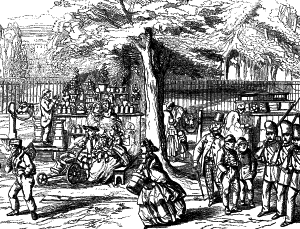 Eight o'clock in St. James's Park, London, 1859 “Sometimes a milkman drove a cow through the suburbs, drawing milk at the door, right into the customers’ jug, to prove that no adulteration was taking place – although this did not prevent the less scrupulous dairymen from ensuring that their cows drank huge quantities of water before setting out. Until the 1880s there was a cow in St. James Park to supply milk on demand for nurses and children out for their daily walks.”
|
Disclaimer The information on this website is provided for informational purposes only... read more |





























